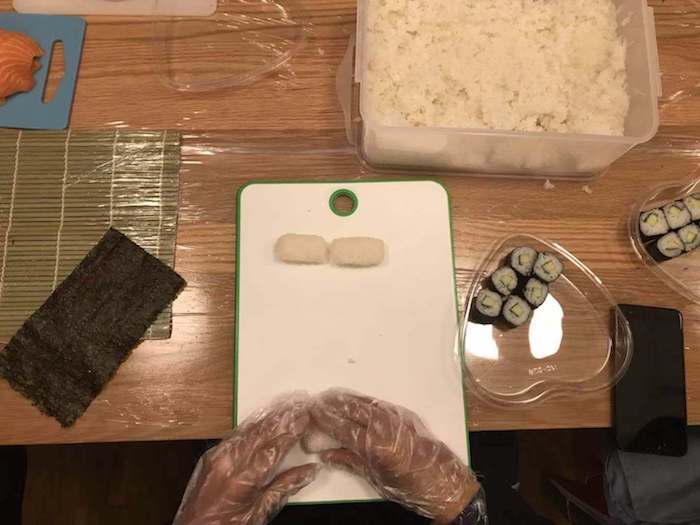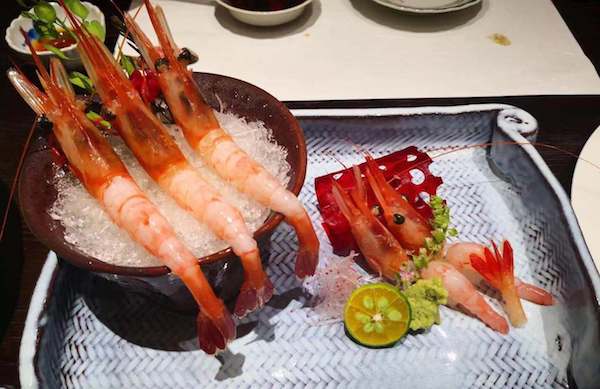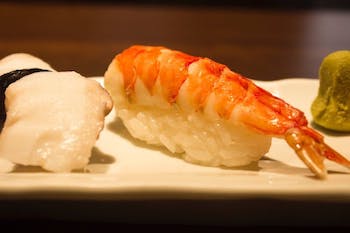We are reader supported. When you purchase through links on our site, we may earn an affiliate commission. Also, as an Amazon affiliate, we earn from qualifying purchases.

Ebi sushi is a common dish in sushi restaurants and a favorite among diners. However, most diners cannot put a name to the dish – most refer to it simply as sushi or shrimp. I did some digging (and tasting) and came up with some interesting facts about ebi sushi.
So, what exactly is
Read on to learn how to prepare the perfect ebi sushi as well as to get an insight into a variety of other ebi sushi preparation methods.
How is Ebi Sushi Prepared?
The word ‘ebi’ is Japanese and refers to a traditional method of preparing shrimp. The main aspect of this method is that the shrimp is ‘butterflied’, which means that it is dissected, split open from the bottom, and laid out flat.
Preparation, however, involves more than just cutting. Here is a comprehensive recipe for preparing ebi sushi:
Ingredients
- Black Tiger shrimp with the heads removed – any type of shrimp will do but the Japanese prefer the Black Tiger species.
- Stove
- Cooking pot like this
- Large bowl
- Small tubs
- Ice
- Bamboo skewers
Preparation
Before you begin working on the dish make sure that the shrimp is completely thwarted. Having done that you can embark on the preparation:
Hold the shrimp with your fingers on the feet and thumb on the spine to straighten it out.
With the shrimp held in position, take a bamboo skewer like this and pierce the shrimp from head to tail. Make sure that you aim for the vein along the top to avoid tampering with the fleshy, delicate bowels. Repeat this for every piece of shrimp and lay them out to boil.
Fill the pot with water and heat it to boiling point – you should do this while preparing the shrimp to save time.
Place the pieces of shrimp in the boiling water.
Pour cold water into another pot and add the ice. Take out the boiled shrimp and dip them into the icy water. The purpose of this is to ensure that the shrimp do not continue cooking from the heat residue as this will surely ruin their delicate texture and taste.
Give the shrimp a minute or two to cool and take them out. Remove the skewers and peel off the shells – you may remove the tails too, albeit it is not necessary, but be sure to leave them intact if you wish to make
Serving
Your ebi sushi is cooked but not yet ready to eat. You need to cut it in its signature butterfly style and do some cleaning before you can tuck in and enjoy. Here is how to go about it:
Hold each shrimp by the tail, turn it upside-down, and lay it flat on a cutting board.
Using a serrated knife cut the shrimp from the head to the tail. Do not slice it completely in half – do not cut in a slicing motion lest you rip the shrimp apart; instead, apply just enough force to cut it only half-way down for the desired butterfly effect.
Split the shrimp open. You will observe that there is brown stuff lining the shrimp all the way in half. This is its food and waste residue. It tastes awful and would ruin the taste of your ebi sushi, so make sure that you rinse it off without leaving any traces behind.
Now your ebi sushi is all ready to serve and eat. You can eat it in this form or marinate it using ginger juice overnight to make it more firm and to add to its flavor.
Serving with Nigiri
Ebi shrimp – and shrimp in general – is popular when served with nigiri. Nigiri is a popular Japanese cuisine that consists of seafood served on a ball of rice.
Now that you know how to prepare ebi nigiri, all you need to do is prepare the rice balls. It is quite easy:
Scoop out a small portion of cooked rice using three fingers.
Place the rice on your palm and roll it applying very light pressure to avoid mashing it.

Roll the rice until it forms an even football shape. Roll enough balls of rice to equal the number of prepared shrimp.
Now take a piece of
Dip the piece of shrimp in wasabi to make it more adhesive to the rice – this is not necessary but it is how traditional Japanese chefs do it, and it adds an exotic flavor to the dish.
Hold the piece of shrimp upside-down and place the rice ball on its open belly. Press down gently on the center of the rice ball to make it stick.
Roll both the fish and rice ball from your palm to your fingers and press down on the rice to make it stick even further. Do this for all the pieces before serving on a plate with the fish on top of the rice balls.
It is recommended to eat the nigiri in one bite to avoid disintegrating the rice. If you are going to dip the nigiri into soy sauce ensure that the sauce does not come into contact with the rice as it will make it disintegrate and ruin the meal.
Other Types of Ebi Delicacies
As mentioned, ebi refers to a method of preparing shrimp. Ebi sushi is a general term that refers to the most popular shrimp preparation method. Other types of ebi preparation methods include:
Kuruma Ebi
Kuruma ebi is prepared from the Japanese species of Tiger prawn. It is served whole with its head, shell, and tail intact – however, diners can opt to have the shell removed, fried, and served side-to-side with the soft shrimp. Traditionally, Kuruma ebi is served raw while still fresh. It is especially popular when served with nigiri. Its liver is also a popular delicacy when served with rice. However, Kuruma ebi can be boiled to bring out more of its rich flavor and/or for preservation purposes.
Ama Ebi

The Japanese word ‘ama’ translates to ‘sweet’ – to this end, aba emi is directly translated to mean sweet shrimp. The species of shrimp used to make ama ebi originates from two regions in Japan: Hokkaido and Maine. It is butterflied and sashimi and served raw while still fresh – as the name suggests, it is particularly sweet in its raw form and thus does not necessitate preparation. It can be served with nigiri and other side-dishes.
Sakura Ebi
Sakura ebi is translated to mean spring-season shrimp. To this end, it is mostly available during spring and especially in the month of May. This species of shrimp is caught in Suruga Bay in Japan – it is very rare in other regions, which further contributes to its rarity in the U.S.
Sakura ebi is very delicate and should be served while still fresh or else it will lose its exotic flavor and delicate texture. It should only be served raw while whole. It can also be served with side-dishes consisting of fried or dried fritter.
Botan Ebi
You will be forgiven for confusing botan ebi with ama ebi as both dishes are eerily similar in appearance and taste. However, the former is plumper and larger than the latter. It is also easier to come by – it is fished from the Hokkaido and Toyama regions of Japan but chefs are raising them in farms in the U.S. It is served raw as both sashimi and sushi.
Shiro Ebi
Shiro ebi is prepared using the tiniest species of shrimp on the list. In fact the shrimp is so tiny that several pirces have to be served together to make it wholesome. This species of shrimp is fished from the Toyama region of Japan. It is best served fresh, but unlike other species on the list it can be frozen without altering its texture or taste – the freezing process is specialized. It is eaten raw and can be served with side dishes such as nigiri. It packs a sweet taste that closely resembles ama ebi.
Reasons Behind The Popularity Of Ebi
In Japan, the use of Ebi prawns is not limited to sushi alone but they are used in a variety of cuisines. They are not only used in home-cooked food and lunch boxes but also served as delicacies at various restaurants around the country. Here are some of the reasons behind the popularity of this tiny-sized seafood.
1. Cheaper version of shrimp
Ebi is a much cheaper alternative of small shrimps or bay shrimps that have declined these days due to overfishing. It is often used as an alternative for the popular Black Tiger Shrimp that makes for an amazing sushi delight. In many Japanese dishes, it is often used as a substitute for Kuruma Ebi that has given away due to less cultivation.
2. A Tasty Ingredient
Whether you use this shrimp in making sushi or any other Japanese delicacy, it serves as a delicious ingredient when prepared with care and precision. In sushi, all the ingredients are treated with the utmost care and attention to detail. The chef’s perfect balance of each ingredient helps in bringing out the subtle flavors perfectly.
3. Visually appealing
The method of preparing ebi calls for boiling it and then splitting it open from the belly portion to create a butterfly shape. The precisely cut and laid out ebi is then used on a bed of rice to make shrimp nigiri. The tail part is left to add to the visual appeal. This delightful and delicious sushi makes a visual treat for the guests with bright colors and flared out butterfly shape.
4. Ebi Fry
If you are a fan of deep-fried foods or your husband/ boyfriend can’t have enough of crispy seafood snacks then you must try the ebi fry. This dish is a specialty in the Nagoya city and it mainly comprises of fried shrimp that is breaded with Panko and then deep-fried. It is served with tartare sauce, hoisin sauce, Worcester sauce, or lemon juice.
5. Versatile
Ebi shrimp has a versatile use in the Japanese kitchen where some of the food is highly influenced by western cooking styles and techniques. This is a classic sushi delicacy that you can find in almost all cafes and restaurants in Japan, and they are savored by both locals and visitors. It is also considered as a popular treat for the Bentos or lunch boxes.
Ebi sushi also varies a lot from its Japanese counterparts like shrimp tempura. With its use, you can enhance the flavor of the exotic Japanese dishes.
Related Questions
Which is the best dish to serve with ebi sushi?
Ebi sushi is delicious in its plain form as long as you prepare it according to the recipe. However, it also goes down well with nigiri, and dipping it in soy sauce adds a nice flavor and helps soften its texture. It also wouldn’t hurt to try it with dried or fried fritter.
Related article: Why Is Ginger Served With Sushi?
How do you rinse the brown waste inside the ebi sushi after boiling and butterflying?
Any method will do as long as you get rid of the waste. However, the best approach is to use a clean piece of cloth and clean water. Wipe the brown stuff off in a straight line to avoid spreading it to the rest of the shrimp and then rinse off with clean water.
I tend to mess up my nigiri when dipping in soy sauce. What can I do about it?
As recommended, dip the nigiri in the soy sauce with the shrimp at the bottom to avoid disintegrating the rice. It is perfectly okay to use your hands as chop-sticks may be difficult to handle for the inexperienced diner; in
Related Article: How To Eat Sushi In Japan (Sushi Eating Etiquette)
How long can the cooked ebi shrimp last in the refrigerator?
If you wish to increase the shelf life of cooked ebi shrimp for enhanced quality and safety, we suggest that you wrap them in a heavy-duty plastic wrap or aluminum foil. You may then refrigerate them in a shallow airtight container. When stored in optimum conditions, cooked shrimps can last for 3-4 days.
How can cooked shrimps stay good in the freezer?
To extend the shelf life of cooked shrimp further, we suggest that you store them in an airtight container or zip-locked bag, and keep inside the freezer. When stored at optimum conditions, it can stay good for 2-3 months and if constantly kept at a temperature of 0°F, the shrimps can stay good indefinitely.

